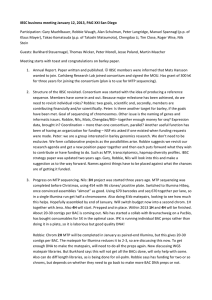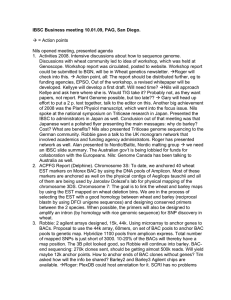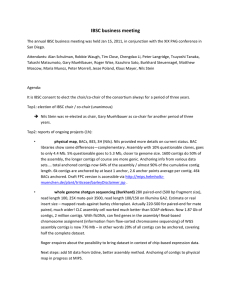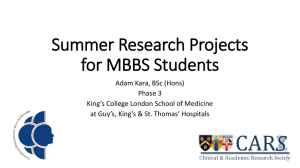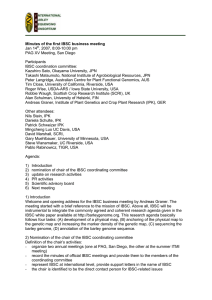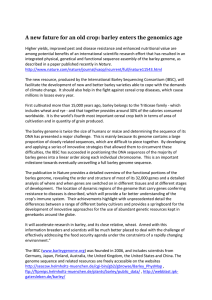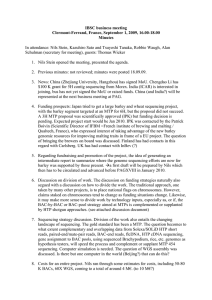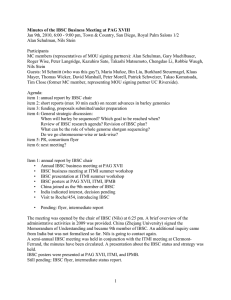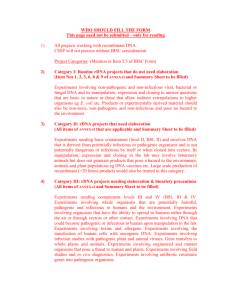Minutes of the International Barley Sequencing Consortium Business Meeting Agenda:
advertisement
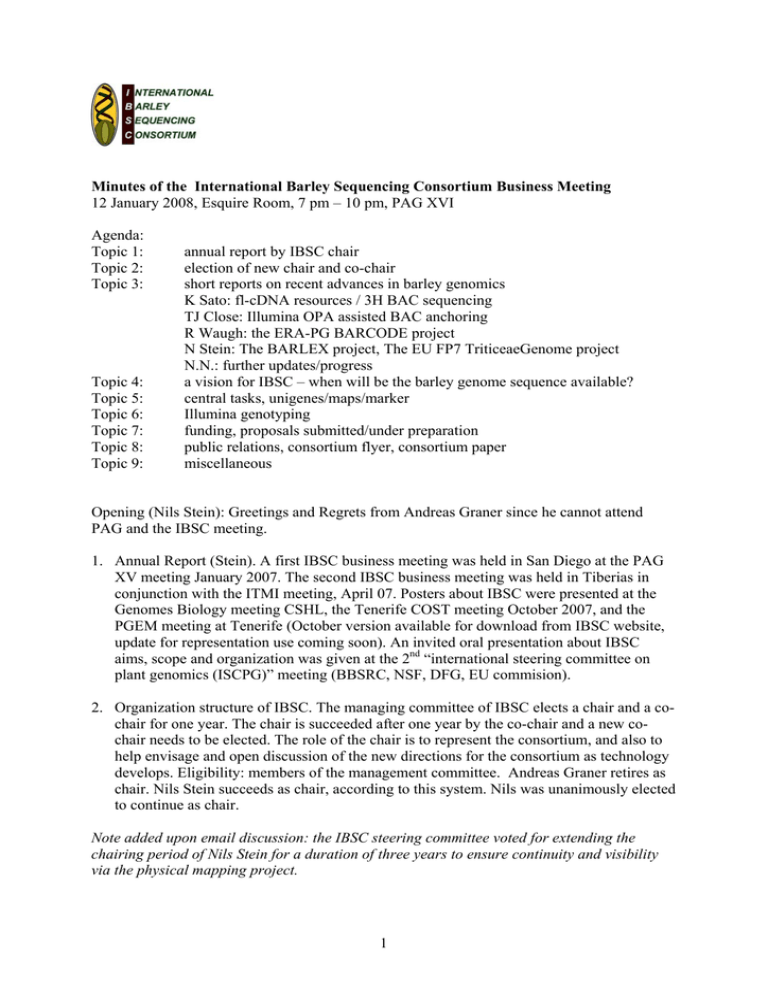
Minutes of the International Barley Sequencing Consortium Business Meeting 12 January 2008, Esquire Room, 7 pm – 10 pm, PAG XVI Agenda: Topic 1: Topic 2: Topic 3: Topic 4: Topic 5: Topic 6: Topic 7: Topic 8: Topic 9: annual report by IBSC chair election of new chair and co-chair short reports on recent advances in barley genomics K Sato: fl-cDNA resources / 3H BAC sequencing TJ Close: Illumina OPA assisted BAC anchoring R Waugh: the ERA-PG BARCODE project N Stein: The BARLEX project, The EU FP7 TriticeaeGenome project N.N.: further updates/progress a vision for IBSC – when will be the barley genome sequence available? central tasks, unigenes/maps/marker Illumina genotyping funding, proposals submitted/under preparation public relations, consortium flyer, consortium paper miscellaneous Opening (Nils Stein): Greetings and Regrets from Andreas Graner since he cannot attend PAG and the IBSC meeting. 1. Annual Report (Stein). A first IBSC business meeting was held in San Diego at the PAG XV meeting January 2007. The second IBSC business meeting was held in Tiberias in conjunction with the ITMI meeting, April 07. Posters about IBSC were presented at the Genomes Biology meeting CSHL, the Tenerife COST meeting October 2007, and the PGEM meeting at Tenerife (October version available for download from IBSC website, update for representation use coming soon). An invited oral presentation about IBSC aims, scope and organization was given at the 2nd “international steering committee on plant genomics (ISCPG)” meeting (BBSRC, NSF, DFG, EU commision). 2. Organization structure of IBSC. The managing committee of IBSC elects a chair and a cochair for one year. The chair is succeeded after one year by the co-chair and a new cochair needs to be elected. The role of the chair is to represent the consortium, and also to help envisage and open discussion of the new directions for the consortium as technology develops. Eligibility: members of the management committee. Andreas Graner retires as chair. Nils Stein succeeds as chair, according to this system. Nils was unanimously elected to continue as chair. Note added upon email discussion: the IBSC steering committee voted for extending the chairing period of Nils Stein for a duration of three years to ensure continuity and visibility via the physical mapping project. 1 A discussion was initiated of possibilities to bring new persons into the steering/managing committee. Tim Close proposes that he step down off Steering Committee, to be replaced by Gary Muehlbauer. Accepted. Co-chair discussion – should be person involved in genome projects on some level. Representation of different nations/continents was raised as a strategically important aspect. Gary Muehlbauer was proposed and selected unanimously. 3. Short reports a. Kazuhiro Sato: Barley BAC sequencing by 454. 10 or 20 BAC clones pooled and used for shotgun sequencing. Need to modify protocol to avoid E. coli DNA. Such a protocol has been worked out by David Edwards group, ACPFG, Australia, and can be made available upon request. 777 BOPA1 markers were mapped onto Harun Nijo /H602 providing anchoring points for map integration. b. Tim Close. Genotyping platform development for barley – a second Illumina Oligo Probe assay for barley - BOPA2 – will be assembled from POPA2 and POPA3 by Spring 2008. BOPA1 has been used for gene/BAC address deconvolution: pooling of BACs in a way that seven positive hits would give 1 BAC (used pooling strategy of N. Thierry-Mieg in BMC Genomics). A new pooling strategy for high throughput screening: the Shifted Transversal Design. The strategy used by the Riverside group was based on a 13-cubic array = 2197 BACs, providing 3-decodability with 7 layers, using a total of 91 pools containing 169 BACs each. This could be expanded to 10,985 minimal tiling path BACs using 5 plates, solving gene-BAC relationships for an estimated 1500 SNPs using BOPA1 and BOPA2. Results so far, for example are: 3H has 88 MTP BACs assigned to the genetic map, plus 8 to an arm only, for a total of 96 MTP BACs on 3H. BOPA1 targets SNPs mainly in stress-related genes that were pre-enriched in the BAC pools, so the success rate was higher than would be the case using randomly chosen gene-bearing BACs. 14.5% is the expected frequency of SNPs that can be placed onto randomly selected gene-bearing BACs. Robbie: We will approach 1000 mapped genes by OPA and SFP eg on chrom 3. How are we going to link these to BACs effectively? One way to deconvolute – take a BAC assembly, and then ask, is there any assembly that matches all the data re SNPs. Robbie – TritceaeGenome. One approach, run BAC pools via microarray hybridization. OPA was the other solution. But no wrt SNP. Just the hybridization. Much talk about deconvolution strategy. c. Robbie Waugh BARCODE. In addition to high-throughput mapping of barley morphological mutants as outlined in the barley workshop the project will deliver Pairedend reads from 250-300k clones. About 2% of the ends will be genes, so more than 10k genes will be linked to map. d. Alan. Short overview about what is COST Action FA0604 Tritigen and what has already happened in frame. Next COST FA0604 workshop in conjunction with the next PGEM meeting, Bulgaria, Sep 2008. e. Nils. Intro about BMBF FABI-BARLEX project. Improve Physical map construction. By additional 200k HICF clones (in total 550k = 12—15 X converage, target to befinished by December 2009. All together at the end, 4 enzymes for 7 libraries. 176k clones assembled, into 26k contigs at the moment, with 5 clones per contig on average. f. Roger Wise. Annotation program for retrotransposons: TEnest. Kronmiller et al. 2008 Plant Physiol. 146, pp. 45–59. g. Peter Langridge / David Edwards: SOLiD platform being trained for wheat and barley at Brisbane/Adelaide. We should make sure that everyone has/could get access to DNA from same key BAC pools. Discussion needs to be continued via email. 2 4. Nils: A vision for IBSC – when will the barley sequence be available? Is our way of building a physical map still state of the art? Would a 100x shotgun sequencing of the barley genome do the same job? Scenario: Soon have long 454 reads (400 bp, 400 Mb /run) available; barcoded reads of BACs in pools for sequencing is working; paired-end technology is available for 454, Illumina/Solexa and Solid. 10 runs = 1x coverage (almost), 1000 runs = 100x coverage. 1 machine for 1 year per partner (6 IBSC partner countries) would be occupied = 166 runs, costs = ~10 million euro. And build bioinformatics at the same time (another 10 Mio Euro?)! Can we handle it, assemble it? In addition to such a deep shotgun the barley community raised/raises: 500k BAC end reads, 3500 survey-sequenced BACs, 0.5 M ESTs (more to come by 454 soon), 25 000 flcDNA from Japan, minimum 5,000 mapped genes, 12 – 15x fingerprint map (by end 2009). Would require some 3 M Euro per country (6 partners). Question is - where can we put the flags? Annotation/Bioinformatics for the flag-placing. Matsumoto raised: 1) what is the quality wanted? 99.5% as in rice and Arabidopsis? This would require Sanger, he says. 2) what is the timeframe? Short time cannot use Sanger. Maybe 7 years! 200 M USD for 99.5% for whole genome rice! Robbie: do we need 100 X?? Nils: Scenario needs computer simulation support Alan: accuracy should not be the sacred cow, because resequencing will solve this for regions of interest. Also, why not chromosome by chromosome? David Edwards: talked about Brassica sequencing—still continuing with BAC by BAC. Roger Wise: Iowa State will get a new sequencer, but thinking still about the platform. How to raise 2M€ per country? Technological issue – how to take available resources, to tackle a big sequence by shotgun? Robbie: Will be a workshop in Autumn run by Mike Bevan to talk about shotgun assembly of large genomes. Nils will continue discussion on this since a conclusion about the appropriate strategy was not made – however, the discussion documented that IBSC needs to reposition and revise the working Agenda on the basis of new technological developments and the success of resources building during the past 1.5 years. Way of getting funding agency heads together around a table is worth looking into. Robbie: models for assembly. EBI is now interested in plant genomics, Ewen Bernie (??). see Topic 7. 5. Nils: central tasks, unigenes/maps/marker. There is a need to formally agree on a reference unigene set. Dave Marshall – has a resource to cross-reference unigene sets from different origin. Different unigene sets were done by different approaches for different purposes. Need to generate one set for the community (anew set?) — the number generated from ESTs, and from that the number that have been mapped. Matsumoto: fl-cDNA sequencing relies on a library comprising 117,000 clones. So far, both ends of the clones were sequenced now the internal part of 20,000 clones is in progress. Dave Marshall: an assembly should be made with all current cDNAs. The end sequences (NIAS) will become available in summer of 2008. Perhaps all data, Matsumoto and Sato, will be published by the end of 2008. Integrate this new ESTs based on Tim’s current assembly? There is a need for a document, citing where we are regarding the resources – eg, say that Tim’s assembly is best now, but that a new assembly is coming. Nils: we need to have a working reference. 3 Robbie—two issues: a unigene set decided; relate the various markers etc. to the set. Decide on Assembly 35 which is a relatively relaxed assembly. Need to unite maps and marker sets. Nils: build a task force to assemble all the datasets suggestions: David Marshall (SCRI), Uwe Scholz (IPK), Steve Wannamaker (UCR). Dave Marshall volunteered to assemble the current state information (unigene – markersets relationship) and summarize until April 2008 – goal: joint publication for unigene, map, marker resources in barley. 6. Robbie: In general we should all work to encourage people to use the established barley Illumina OPA platform. Probe sets purchased by Robbie Waugh are available for shared use on cost recovery basis – directly get in touch with Robbie Waugh (SCRI) Publication of OPA will move forward the popularization. Mapping of genetic diversity in three populations. 7. New funding initiatives, proposals Robbie: a UK action has submitted a proposal for a pilot study to assess possibilities for high-throughput sequencing in large genomes (e.g. Triticeae). Project will be led by Mike Bevan. Wheat+barley, using Brachypodium and rice as scaffords. The annual call for proposals by JGI has been discussed – new proposal would be due for January 21st. Can this deadline be matched – who takes the lead – not decided, need for further assessment of the overall strategy. Are there besides the one-year calls, other mechanisms to cooperate with JGI? JGI still doesn’t want to deal with BACs. Shotgun is easier to manage, than is tracking BACs. Problem: JGI keeps saying that “barley is not a bioenergy crop that is on their list.” Nils: to find international funding for the IBSC goals and milestones is the crucial task for the coming year – there needs to be a clearer sign of true international commitment. Catherine Feuillet coordinates an EU FP7 proposal (TriticeaeGenome) which is close to final approval - ~5 Mio Euro for wheat and barley (mainly physical map construction and anchoring. Proposals in earlier preparation status: Peter Langridge: a 10 M dollar (AUS) proposal put in. Robbie Waugh: EBI/MIPs/France for bioinformatics tools for assembly for wheat and barley in the new ERA-PG call to be initiated – dicussions in progress. 8. Public relations Nils: Poster and website should be updated. Updated poster and part of the PAG talk about the status of the physical map will be provided to Roger Wise for updating the website. IBSC-Flyer: At the spring IBSC business meeting in Tiberias a discussion addressed whether a polished flyer about IBSC scope, goals, message would be advantageous and important. A vote was performed against such a need because making such a flyer may be a labor intensive and time consuming task. Based on the feedback of funding agency members at the ISCPG meeting at Tenerife, Oct 2007, the point was raised again, since such flyers seem to be a relevant and important instrument to reach the attention of politicians and funding agencies. Important – a flyer needs to be easy to read, easy to see. Templates for making of such flyer are available: Peter Langridge—prepared a “business case” brochure. Gary Muehlbauer – prepared one for Barley CAP. Gary and Roger form a task force to further develop an IBSC flyer based on the available templates. IBSC website: Roger: request for circulating the website texts for commenting, rephrasing and updating. Peter, Gary, and Roger will interact on this. Consortium paper: Robin Buell invited IBSC to submit a barley consortium paper on biology and genomics (resources) for a January 2009 special issue on grass genomics. 4 Nils will come up with a concept and coordinate the writing. Manuscript needs to be submitted by September 2008. Further possibilities for publishing the IBSC message could be: Gramene Newsletter, IBGS publication (Andreas Graner is invited as key note speaker) – likely the conference proceedings will be published.. 9. Miscellaneous Next meeting will be in conjunction with the IBGS in Alexandria, Egypt. List of participants Person Dave Edwards Takashi Matsumoto Kazuhiro Sato Alan Schulman Brent Kronmiller Klaus Mayer Patrick Schweizer Prasanna Bhat Gary Muehlbauer Tim Close Jaroslav Dolezel Hana Simkova Matthew Moscou Robbie Waugh Frank Ordon Dave Marshall Peter Langridge Roger Wise Thomas Wicker Nils Stein Institution ACPFG NIAS email DAVE.EDWARDS@UQ.EDU.AU mat@affrc.go.jp OKAYAMA UNIV UNIV HELSINKI & MTT ISU MIPS; GSF IPK UCR UMN UCR IEB OLOMOUC IEB OLOMOUC ISU SCRI JKI SCRI ACPFG USDA-ARS/ISU UNIZH IPK kazsato@rib.okayama-u.ac.jp alan.schulman@helsinki.fi bak@iastate.edu k.mayer@helmholtz-muenchen.de schweiz@ipk-gatersleben.de prasanb@ucr.edu muehl003@umn.edu timothy.close@ucr.edu DOLEZEL@UEB.CAS.CZ SIMKOVAH@UEB.CAS.CZ moscou@iastate.edu Robbie.Waugh@scri.ac.uk f.ordon@bafz.de David.Marshall@scri.ac.uk peter.langridge@acpfg.com.au rpwise@iastate.edu wicker@botinst.unizh.ch stein@ipk-gatersleben.de Gatersleben, March 12, 2008 Nils Stein (extended version of minutes taken by Alan Schulman, comments Roger Wise, Tim Close) 5
